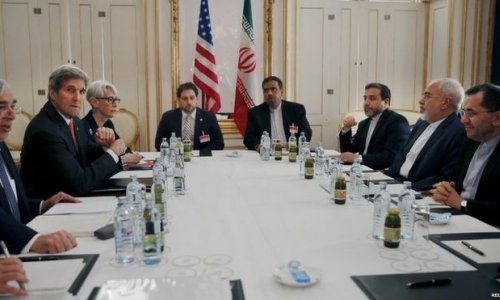Turkey and the United States have agreed on the outlines of a de facto "safe zone” along the Turkey-Syria border under the terms of a deal that is expected to significantly increase the scope and pace of the U.S.-led air war against the Islamic State in northern Syria, according to U.S. and Turkish officials.
The agreement includes a plan to drive the Islamic State out of a 68-mile-long area west of the Euphrates River and reaching into the province of Aleppo that would then come under the control of the Syrian opposition. If fully implemented, it would also bring American planes in regular, close proximity to bases, aircraft and air defenses operated by the Syrian government, and directly benefit opposition rebels fighting President Bashar al-Assad’s regime.
Operations in the targeted area would stop short of meeting long-standing Turkish demands for a full-scale, declared no-fly zone, but the area could eventually become a protected haven for some of the estimated 2 million Syrian civilians who have fled to Turkey.
The first word of the agreement came last week, when Turkey said it had agreed to allow armed U.S. aircraft to fly out of its base at Incirlik. Turkish jets have begun flying missions into northern Syria.
Additional details, including the composition of Syrian opposition forces that are to be inserted on the ground to hold the protected area, are still being worked out, according to the officials, who spoke on the condition of anonymity to discuss the evolving operations.
"When areas in northern Syria are cleared of the [Islamic State] threat, the safe zones will be formed naturally,” Turkish Foreign Minister Mevlut Cavusoglu told journalists in Ankara on Saturday. "People who have been displaced can be placed in those safe areas.”
U.S. officials did not dispute the Turkish description and said U.S. and coalition air cover would effectively operate around the clock as Islamic State targets were located. But they said the United States would not officially designate the area — about 40 miles deep into Syria along the 68-mile stretch of border — a protected zone.
A senior administration official, speaking on the condition of anonymity, said in a statement late Sunday that "any joint military efforts” with Turkey "will not include the imposition of a no-fly zone.”
"What we are talking about with Turkey is cooperating to support partners on the ground in northern Syria who are countering ISIL,” the statement said. "The goal is to establish an ISIL-free zone and ensure greater security and stability along Turkey’s border with Syria.” ISIL is another term for the Islamic State.
NATO’s secretary general said Sunday that the alliance’s 28 members will hold consultations Tuesday in Brussels in response to a Turkish request that followed a suicide bombing in Turkey last week. The consultations are under NATO’s Article 4, allowing any member to convene a meeting when it believes its territorial integrity or security is threatened.
NATO deployed Patriot anti-missile batteries to Turkey in early 2013, after Turkey charged in Article 4 consultations that its citizens had been killed by Syrian government missiles fired across the border and that Syrian planes had violated its airspace.
The Obama administration has long resisted establishing Syrian safe zones, protected by U.S. and coalition air power, and has said its air operations would target only the Islamic State. The Pentagon has maintained that targeting regions of western Syria, near where the government is fighting numerous rebel and militant groups, could provoke a clash with Syrian air defenses that are centered in that area.
Turkey had previously refused use of Incirlik as a base for U.S. air attacks unless the United States agreed to establish a protected zone along the border.
But several aspects of the conflict have changed for both governments since they first formally discussed the issue late last year.
Assad’s forces have lost considerable ground in the northwest, including in and around Aleppo, Syria’s second-largest city, to a coalition of moderate and non-Islamic State militant forces in recent months. At the same time, the Islamic State, driven by Kurdish-led forces out of many of its northern strongholds to the east of the Euphrates toward the Iraqi border, began to push westward. The militants now control Syria along the border from the river to a point near the Syrian town of Azaz, north of Aleppo.
Turkey’s change of heart began about six weeks ago, after a push by the Islamic State in May to capture Azaz, the most vital border crossing for U.S.-backed moderate rebels. The offensive was kept at bay, with the belated help of limited U.S. airstrikes. Syrian rebels, who called urgently for air support at the time, complained that convoys of Islamic State soldiers had converged toward their positions without any intervention by coalition warplanes.
U.S. officials subsequently noted that those Turkish-requested strikes would have been more effective if planes could have flown from Incirlik, about 250 miles away, rather than from a faraway base in Bahrain.
The zone now open for U.S. strikes stretches east from Azaz to Jarablus, on the Euphrates. According to Turkish media accounts, it will extend southward to the town of al-Bab, on the outskirts of Aleppo, but will not include Aleppo itself.
It was unclear whether the administration has informed the Syrian government of its new operations in the northwest. The U.S. government had indirectly warned Assad not to interfere with U.S. airstrikes against the Islamic State that began in September in northern, central and eastern Syria. But those strikes were not seen as a problem, since the Syrian government had basically ceded those areas to the militants and conducted minimal operations.
Once the area is cleared, the plan is to give control to as-yet-unidentified moderate Syrian rebel groups. The United States and Turkey have differing interpretations as to which groups can be defined as "moderate.”
It would then be possible for displaced civilians to find refuge in the area, something that would go a long way toward fulfilling Turkish ambitions for a way to ease the refugee problem in Turkey.
Eliminating the Islamic State from the area under focus would be a major strategic blow to the group, depriving the militants of their last remaining points of access to the outside world. After losing control of the important border crossing of Tal Abyad to Kurdish forces in June, the Islamic State controls only two small crossings, at Jarablus and al-Rai, through which to smuggle foreign fighters. Those border towns are the next priority in the fight against the Islamic State, U.S. and Turkish officials say.
The speed with which the militants crumbled in Tal Abyad, under withering U.S. airstrikes and little in the way of ground fighting, demonstrated that air power can work against the group, U.S. and Kurdish officials said. Tal Abyad is located east of the Euphrates and the city of Kobane, where Kurdish-led forces, assisted by U.S. airstrikes and Turkish supply lines, drove out the Islamic State early this year.
(The Washington Post)
www.ann.az
Follow us !









